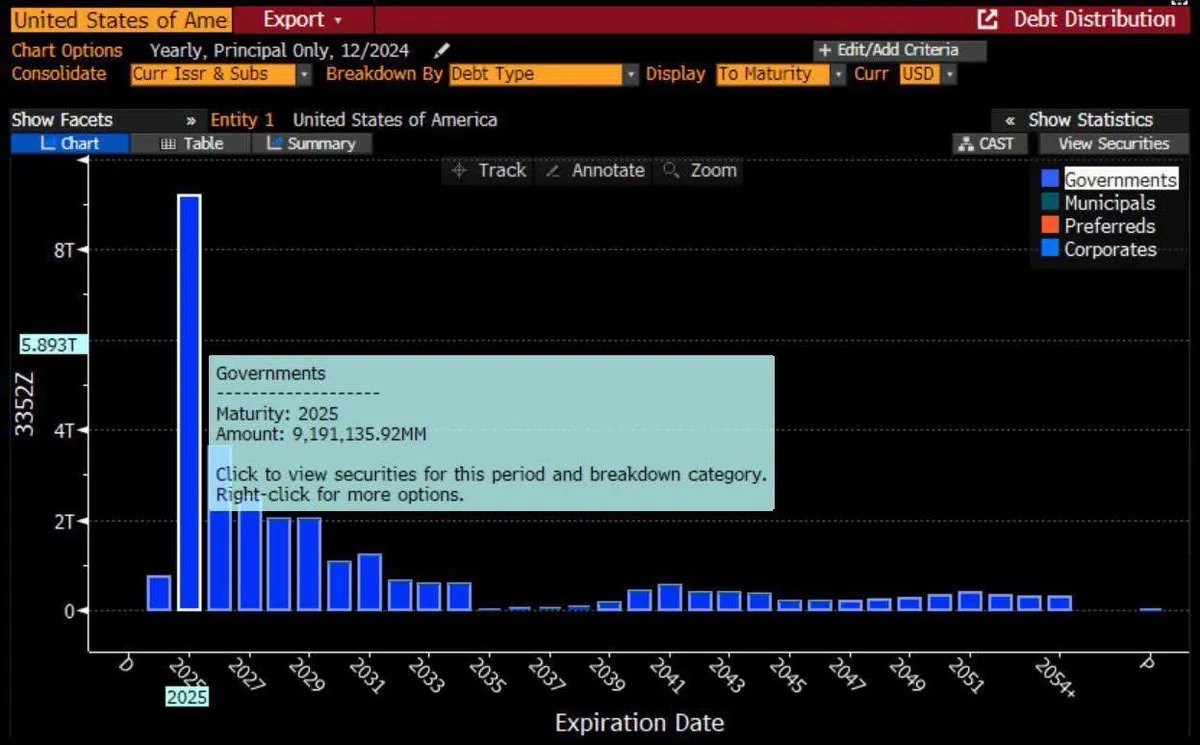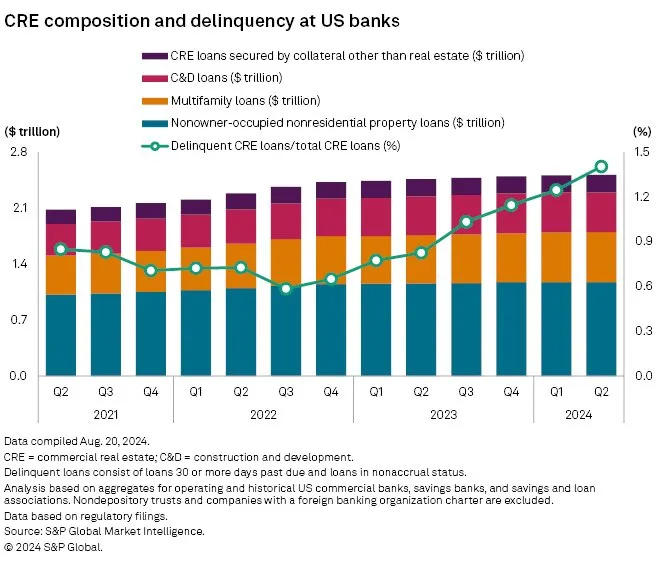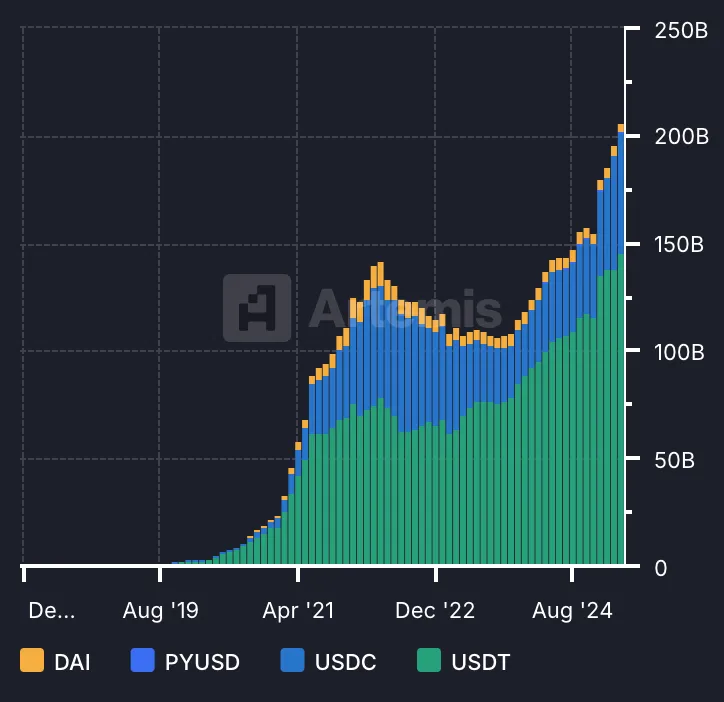Author: DeFi Cheetah, Crypto KOL
Compiled by: Felix, PANews
As previously predicted, the U.S. stock market is expected to experience at least a 20% pullback, bringing the price of Bitcoin back to around $50,000. The first target has been achieved: due to Trump's imposition of stricter tariffs on many other countries, the U.S. stock market underwent a 20% pullback with the VIX index around 55. The price of Bitcoin once fell to $74,000, showing more resilience than expected based on historical price trends.
Next, it is anticipated that the Federal Reserve will cut interest rates before June, followed by a rebound in the U.S. stock market and the crypto market. In fact, Trump has just explicitly requested Federal Reserve Chairman Powell to lower interest rates. This article will explain in detail why Trump is so obsessed with interest rate cuts and why the crypto market is viewed positively.
Two Urgent Issues Caused by High Interest Rates
In the coming months, two issues will force the Federal Reserve to significantly cut interest rates. First, the "maturity wall" of $9 trillion in government bonds this year is compelling the Trump administration to seek interest rate cuts to save trillions in refinancing costs. However, from the Fed's perspective, the current level of inflation does not leave room for rapid rate cuts. Therefore, the seemingly unreasonable aggressive policies and measures of the Trump administration (such as tariffs and the establishment of DOGE) can best be explained as a coordinated mechanism attempting to leverage macroeconomic uncertainty to pressure the Fed into cutting rates. Otherwise, the U.S. government will have to pay at least 3-4 times the interest after extending the maturities. In fact, the yield on two-year short-term government bonds has been declining, reflecting market risk aversion and capital inflow into government bonds.

In the eyes of the Trump administration, the urgency of cutting interest rates can be explained by the following chart:

In fact, the surge in the Bank of America Merrill Lynch Option Volatility Estimate Index (MOVE), which measures the volatility of U.S. Treasury market interest rates, further supports the likelihood of the Fed cutting rates. This index is seen as a representation of the term premium of U.S. Treasuries (i.e., the yield spread between long-term and short-term bonds). As this index rises, anyone engaged in financing transactions involving U.S. Treasuries or corporate bonds will be forced to sell due to higher margin requirements. If the MOVE index continues to rise, especially above 140, it may indicate extreme market instability and could compel the Fed to stabilize the Treasury and corporate bond markets through rate cuts, as these markets are crucial for the normal functioning of the financial system. (Note: The last time the MOVE index surged above 140 was due to the collapse of Silicon Valley Bank—the largest bank failure since 2008.)

The second reason for a significant rate cut in the coming months is also due to the "maturity wall," but this time referring to over $500 billion in U.S. commercial real estate (CRE) loans maturing this year. Many CRE loans were previously underwritten at lower rates during the pandemic and now face refinancing challenges in a continuously rising interest rate environment, which could lead to increased default rates, especially for highly leveraged real estate. The growing prevalence of remote work has triggered structural changes, resulting in persistently high vacancy rates post-pandemic. In fact, a potential large-scale default on CRE loans could cause the MOVE index to soar.
In the fourth quarter of 2024, the delinquency rate for CRE loans was 1.57%, up from 1.17% in the fourth quarter of 2023. Historical data indicates that rates above 1.5% are concerning, especially in a tightening monetary environment. Meanwhile, with vacancy rates as high as 20%, capitalization rates continuously rising (around 7-8%), and a large volume of loans maturing, the value of office buildings has dropped by 31% from peak levels, increasing the risk of default.

The logic here is that high vacancy rates will reduce net operating income (NOI), lower debt service coverage ratios (DSCR), and debt yields, but will increase capitalization rates. High interest rates will exacerbate this situation, especially for loans maturing in 2025, where refinancing at higher rates may become unsustainable. Therefore, if commercial real estate loans cannot be refinanced at reasonable low rates similar to those during the pandemic, banks will inevitably face more bad debts, which in turn could trigger a "domino effect" leading to more bank failures (recall the severity of bank failures like Silicon Valley Bank in 2023 due to soaring interest rates).
Given these two urgent issues caused by current high interest rates, the Trump administration must take aggressive measures to cut rates as soon as possible. Otherwise, these debts must be extended, and the U.S. government will face higher refinancing costs, while many commercial real estate loans may not be able to be extended, resulting in a large volume of bad debts.
Catalysts for the Next Bull Market—Stablecoins
The most significant impact on the crypto market comes from market liquidity. However, the factors that most influence liquidity are (i) monetary policy and (ii) the level of stablecoin adoption. Under the influence of dovish monetary policy, the proliferation of stablecoins can further catalyze capital inflows during a bull market. The potential for price increases in a bull market depends on the increase in the total supply of stablecoins. In the last bull market (2019 - 2022), the total supply of stablecoins grew tenfold from its low to its peak, while from 2023 to early 2025, it has only increased by about 100%, as shown in the chart below.

The following highlights events that indicate a rapid increase in stablecoin adoption over the next year:
- Progress in U.S. Stablecoin Legislation: In the first quarter of 2025, the Senate Banking Committee approved the Stablecoin Act (GENIUS Act) in March, outlining regulatory and reserve rules for stablecoin issuers. This legislation aims to integrate stablecoins into the mainstream financial system, reflecting the growing recognition of their role in the crypto market. Additionally, the House Financial Services Committee passed a stablecoin framework bill—the Stablecoin Act (STABLE Act)—which stipulates that any non-bank institution can issue stablecoins with approval from federal regulatory agencies. Regulatory transparency has long been considered the most important factor influencing stablecoin adoption, thereby affecting capital inflow into the crypto industry through stablecoins.
- Accelerated Institutional Adoption: Fidelity began testing a dollar-pegged stablecoin in late March, marking a significant step for this traditional financial giant into the crypto space. Meanwhile, Wyoming announced plans to launch a state-backed stablecoin by July, aiming to be the first fully reserved token backed by fiat currency issued in the U.S.
- World Liberty Financial Stablecoin: World Liberty Financial, associated with Trump, announced on March 25 its plan to launch a dollar-pegged stablecoin USD1, having previously raised $500 million through a separate token sale. This move aligns with the Trump administration's support for stablecoins as key infrastructure for cryptocurrency trading.
- USDC Expansion to Japan: On March 26, Circle partnered with SBI Holdings to launch USDC in Japan, making it the first stablecoin officially approved for use under Japan's regulatory framework. This move reflects Japan's proactive attitude towards integrating stablecoins into its financial system and may serve as a model for other countries.
- PayPal and Gemini Advancing Stablecoin Development: Throughout the first quarter, PayPal and Gemini solidified their positions in the stablecoin market. The adoption rates of PayPal's PYUSD and Gemini's GUSD have increased, with PayPal leveraging its payment network while Gemini focuses on institutional clients. This has intensified competition among U.S. stablecoin issuers.
- More Use Cases for Payroll Platform Rise: On March 24, payroll platform Rise expanded its services to offer stablecoin payments for international contractors in over 190 countries. Employers can pay wages in stablecoins, and employees can withdraw in local currency.
- Circle's IPO: Circle has submitted an IPO application. If approved, Circle will become the first stablecoin issuer listed on the New York Stock Exchange. This will mark the official status of the stablecoin business in the U.S. and encourage more companies, especially large institutions, to explore this field, as the stablecoin business relies more on institutional resources, distribution channels, and business development.
Why is the Trump administration so actively supporting the development of stablecoins? This aligns with the viewpoint from the first part: the collateral for stablecoins in circulation is primarily short-term U.S. Treasuries, so as the U.S. government extends trillions in maturing government bonds this year, the more widespread stablecoins become, the higher the demand for short-term Treasuries.
The market direction is clear: in the short term, there may be market turbulence, high volatility, and even further declines from current levels. However, in the medium term, it is expected that under a dovish monetary policy, significant interest rate cuts, combined with the proliferation of stablecoins, could trigger another strong bull market comparable in scale to the last cycle.
Now is an ideal time to invest in the crypto market for good returns.
Related Reading: Reviewing the Federal Reserve's 10-Year Interest Rate Cycle: Where Will Bitcoin Go Under Best, Moderate, and Worst Path Scenarios?
免责声明:本文章仅代表作者个人观点,不代表本平台的立场和观点。本文章仅供信息分享,不构成对任何人的任何投资建议。用户与作者之间的任何争议,与本平台无关。如网页中刊载的文章或图片涉及侵权,请提供相关的权利证明和身份证明发送邮件到support@aicoin.com,本平台相关工作人员将会进行核查。




